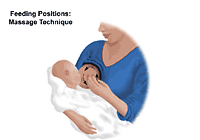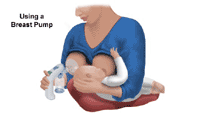Difficulty with Latching On or Sucking
A baby must be able to remove enough milk from the breast during breastfeeding to gain weight and "tell" the breasts to increase or maintain milk production. If the baby does not get enough milk, he or she will have poor weight gain. Also, the amount of milk being made for the baby will decrease.
A baby's ability to suck and remove milk may be affected in different ways. Prematurity, labor and delivery medicine, and conditions such as Down syndrome may initially make it difficult for a baby's central nervous system to remain alert or coordinate suck-swallow-breathe actions. Acute health conditions, such as jaundice or infection and chronic conditions, such as cardiac defects may also influence a baby's level of alertness or the ability to suck. A "mechanical" issue, such as tongue-tie or a cleft lip or palate might directly interfere with a baby's ability to use the structures in the mouth for effective sucking.
Sometimes, the cause is obvious, but often it is not. However, it is important to recognize the signs that a baby is unable to effectively remove milk during breastfeeding so that steps can be taken to remedy any problem. Signs of ineffective sucking may include the following:
The baby who consistently:
Does not wake on his or her own to cue for feedings.
Cues fewer than 8 times in a 24-hour period.
Cues to feed 14 or more times in a 24-hour period.
Latches on and then lets go of the breast repeatedly.
Pushes away or resists latch-on.
Falls asleep within 5 minutes of latch-on or after sucking for only two or three minutes.
Does not suck almost continuously for the first seven to 10 minutes of a feeding.
Nurses on one side for longer than 30 to 40 minutes.
Feeds for more than 45 minutes without acting satisfied or full after a meal.
Produces fewer than 3 to 4 stools in 24 hours (3 to 4 stools per day is normal for a baby who is more than one week old and younger than one month).
Seems "gassy" or produces green, frothy stools after the first week.
Produces fewer than 6 wet diapers in 24 hours (a baby produces 6 wet diapers a day by the end of the first week).
Has difficulty taking milk by other alternative feeding methods.
The mother who:
Has persistently sore or bruised nipples or areola.
Develops red, scraped or cracked nipples.
Often observes misshapen nipples after feedings (for example, creasing or flattening).
Rarely or never notices breast fullness prior to nursing and breast softening after nursing, especially if there are several hours between feedings.
Experiences more than one episode of plugged milk ducts or mastitis.
How you can help with the breastfeeding process
When a difficulty with latch-on or sucking persists beyond the first several days after birth, it can be discouraging. Although most babies will learn to breastfeed effectively if given time, it is important to work with the baby's healthcare provider and a certified lactation consultant (IBCLC) if a baby has difficulty sucking. Until the issue resolves there are several things you can do to help breastfeeding progress while you make sure your baby is getting enough to eat. Always talk with your baby's healthcare provider for more information:
Wake the baby to breastfeed every 2 to 3 hours if he or she is sleepy and still has not mastered feeding cues.
Your baby probably will do better for some feedings. Do not be discouraged if he or she is too sleepy or seems to forget from feeding to feeding.
Some feedings will last longer than others. Your baby may need time to "get going" at the breast for some feeds.
Massage your breast with downward and inward strokes (or use one hand to gently squeeze the breast) to deliver milk into the baby's mouth when he or she is nursing. This is also helpful when your baby begins to fall asleep at the breast too soon after starting to feed.
Chart the number, amount, and color of urine and stools for wet and dirty diapers on a daily record.
Use a hospital-grade, electric breast pump to ensure complete milk removal. Many women will express milk by pumping for several minutes after breastfeeding. How long you will need to continue to pump depends on how quickly your baby learns to breastfeed effectively. Also, how much milk your baby needs to grow beyond what you are providing with breastfeeding.
Weigh the baby regularly or record a test-weight before and after a feeding. This is best done at the office of a lactation consultant or the baby's healthcare provider with a medical-grade scale.
Offer additional calories by giving baby expressed breast milk in a bottle as instructed by your baby's healthcare provider.
Certain breastfeeding devices or alternative feeding methods may encourage effective sucking or provide your baby with additional nutrition during the "learning to breastfeed" process. Although a specific device may have advantages for your situation, every device also has disadvantages. To avoid pitfalls, any breastfeeding device should be used with the guidance of a certified lactation consultant (IBCLC) or healthcare provider with advanced knowledge of breastfeeding. Devices that may be helpful in certain situations include the following:
Nipple shield. A thin silicone or latex nipple shield, which is centered over the nipple and areola, has been shown to encourage a better latch, more effective sucking pattern, and better milk intake during breastfeeding for certain babies.
Feeding tube system. A feeding-tube system may be taped to the breast or your finger so that a baby receives additional milk through the tube when the baby sucks. When a thin feeding tube is attached to a syringe and taped to the breast or your finger (finger-feeding), you or a helper can gently press the plunger to deliver a few drops of milk in the baby's mouth if the baby "forgets" to suck. Commercial feeding-tube systems are also available.
Alternative feeding methods. In addition to a feeding-tube system, there are other alternative feeding methods that will ensure that your baby gets enough food, yet are less likely to interfere with long-term breastfeeding. These include cup-feeding, syringe-feeding, spoon-feeding, or (eye) dropper-feeding. If using a bottle, bottle nipples (teats) with a slower rate of flow usually are preferred.
If any structural variation in the baby's mouth is found, work with the proper healthcare professionals to correct or treat it. Depending on the type of variation, this may involve anything from oral exercises to some type of surgical treatment.
Other ways to help the baby with ineffective sucking
Other hints for the baby include the following:
Skin-to-skin contact seems to help a lot of babies with nursing. This also helps you maintain milk production.
When a baby has the basic idea of effective sucking but cannot seem to do it consistently, try pumping one breast while breastfeeding your baby on the other.
You may want to limit breastfeeding duration if you or your baby get too frustrated or if the feedings take more than 40 to 45 minutes. By stopping when frustrated or limiting the time of feedings, you will have more time to pump and remove milk effectively. You may find it is easier to remain patient through the learning process. You can always express milk and give it by an alternative feeding method.
You may want to let the baby's father or other family members and friends handle alternative feedings, so you do not become overwhelmed. This frees you to concentrate on breastfeeding, maintain pumping sessions, and enjoy periods of cuddling skin-to-skin with your baby.
Do not throw away any breastfeeding device or an alternative feeding method because you did not like it or it did not work when first suggested. The device or method that did not help one day may work great the next and vice versa.
Once your baby is growing and developing properly and his or her nutritive sucking ability is improving, ask your baby's healthcare provider when you can stop waking him or her for feedings and begin to wait to see if he or she will demonstrate feeding cues. You will also want to know when it is safe to start decreasing supplementary breast milk or formula.
Keep thinking positively. It is normal to get frustrated and think your baby will never learn to breastfeed effectively. It is normal if some days seem an eternity of breastfeeding practice, alternative feedings, and breast pumping sessions. It is normal for your confidence to rise and fall. Try to maintain perspective by having a sense of humor. Think about how far your baby and you have come since his or her birth rather than how far you still may have to go.
Get support. In addition to staying in touch with your healthcare provider and a certified lactation consultant (IBCLC), contact a representative of a breastfeeding support organization. He or she will have lots of information and will provide you with moral support whenever you need it.







